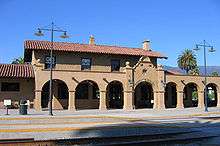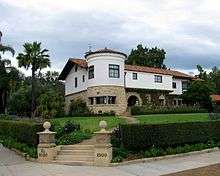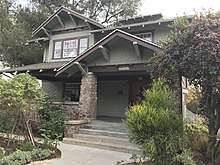Francis W. Wilson
Francis W. Wilson (1870 - 1947) was an American architect. His practice in Santa Barbara, California included work for the Atchison, Topeka and Santa Fe Railway and its associated Fred Harvey Company hotels, as well as many residences.
Wilson was born in Massachusetts and arrived in California at the age of 17 to visit his sister, a schoolteacher in Placerville. There, he worked as a log-driver on the American River and then as a surveyor for the Southern Pacific Railroad. He moved to San Francisco in the early 1890s, becoming a draftsman for the firm of Pissis and Moore, where he was instructed by architect Albert Pissis. Wilson studied at the San Francisco chapter of the American Institute of Architects and took a grand tour of Europe before establishing his own firm in Santa Barbara in 1895.[1][2]

Shortly after arriving in Santa Barbara, Wilson designed homes for Dr. C.C. Park and General Henry J. Strong.[3] He built up a practice designing homes for the wealthy, as well as designing, building and selling speculative houses. His connections with the wealthy led to an interest in polo and amateur horse racing, and to commissions for the Santa Barbara Club, the Central Savings Bank, the Santa Barbara library, post office, and railroad station. A friendship with Edward Payson Ripley, president of the Santa Fe Railway, led to commissions for the railway and for the Fred Harvey Company, as well as a commission to design Ripley's winter home. His most extravagant residential commission, Las Tejas in the suburb of Montecito, was built in 1917 for Oakleigh Thorne.[2]
Wilson married Julia Redington, sister of Wilson's friend and fellow Santa Barbara Polo Club member Lawrence Redington, in 1905.[2]
In 1920, Wilson purchased a forty-five acre ranch in Tuolumne County, California, as well as a nearby mining company. Shortly thereafter, he divorced Redington. During the 1930s, Wilson designed several houses in or near Sonoma, California. During World War II, he took a position as a designer for at Lockheed Aircraft's plant in Burbank, California.[3]

Works
- Charles H. Hopkins Home ("El Nido") (1897), Santa Barbara, California[4]
- Santa Barbara Club (1903), Santa Barbara, California[3][5]
- Bellosguardo (1904), the Graham home in Santa Barbara, California, demolished 1933 and replaced by a new Bellosguardo, the estate of [William A. Clark].[6]
- Santa Barbara Railway Station (1905), Santa Barbara, California, commissioned by Southern Pacific Railroad, listed on the NRHP[3][7]
- Alexander House, Santa Barbara, California (1906)[3]
- Peter H. Murphy Home ("El Tejado") (1907), Santa Barbara, California, now Kerrwood Hall, Westmont College[3][8]
- Potter Theater (1907), Santa Barbara, California, destroyed in 1925 earthquake[9][10]
- El Garces Hotel (1908), a Harvey House hotel in Needles, California, listed on the NRHP
- Seth Cook Rees Home (1908), Pasadena, California[11]
- Santa Barbara Country Club ("Miraflores") (1909), Santa Barbara, California, rebuilt 1913, altered 1915 by Reginald D. Johnson) now the Music Academy of the West[12][13]
- Bright Angel Camp (1909), Grand Canyon, Arizona, a conversion of the Bright Angel Hotel and the Buckey O'Neill Cabin for the Fred Harvey Company, now part of the Bright Angel Lodge complex designed by Mary Colter[14][15]
- Grand Canyon Depot (1910), Arizona, a National Historic Landmark[14]
- Barstow Train Depot ("Casa del Desierto") (1911), a Harvey House located at 685 North First Street, Barstow, California[16][17][18]
- Central Savings Bank (1913), Corner of State and de la Guerre, Santa Barbara, California, destroyed in 1925 earthquake[19][3]
- Santa Barbara Post Office (1914), Santa Barbara, California, now the Santa Barbara Museum of Art (with Oscar Wenderoth, Office of the Supervising Architect), remodeled 1941 by David Adler[20]
- Santa Barbara Public Library (1917), Santa Barbara, California[21]
- Oakleigh Thorne House ("Las Tejas") (1917), Montecito, California, redesign/remodel of estate originally built in 1868)[22]

Gallery
.tiff.jpg) El Garces Hotel, Atchison, Topeka & Santa Fe Railroad, Needles, California
El Garces Hotel, Atchison, Topeka & Santa Fe Railroad, Needles, California Grand Canyon Station, Atchison, Topeka & Santa Fe Railroad, Grand Canyon, Arizona
Grand Canyon Station, Atchison, Topeka & Santa Fe Railroad, Grand Canyon, Arizona "Las Tejas," Oakleigh Thorne House, Montecito, California. View from swimming pool pavilion to house.
"Las Tejas," Oakleigh Thorne House, Montecito, California. View from swimming pool pavilion to house.

References
- Michelson, Alan. "Francis W. Wilson". Pacific Coast Architecture Database. University of California at Los Angeles. Retrieved 10 November 2011.
- Starr, Kevin (1991). Material Dreams: Southern California Through the 1920s. Oxford University Press. p. 260. ISBN 978-0-19-507260-0.
- Cleek, Patricia Gardner (1985). "Francis W. Wilson, Architect". Noticias. 31: 40–53.
- "CSL Catalog - Full View of Record". catalog.library.ca.gov. Retrieved 2018-01-02.
- "About the Santa Barbara Club". Santa Barbara Club. Retrieved 10 November 2011.
- Redmon, Michael (October 25, 2007). "Question: 'Wasn't there another mansion where the Clark Estate is today?'". Santa Barbara Independent. Retrieved 10 November 2011.
- "Guidelines: El Pueblo Viejo Landmark District" (PDF). City of Santa Barbara. pp. 11, 32. Retrieved 10 November 2011.
- "Magazine | This Old House The Chronicle of Kerrwood Hall". blogs.westmont.edu. Retrieved 2018-01-02.
- "'I would like to know more about the Potter Theatre. Was it part of the Potter Hotel?'". www.independent.com. Retrieved 2018-01-02.
- "PCAD - Potter Theatre, Santa Barbara, CA". pcad.lib.washington.edu. Retrieved 2018-01-02.
- "CALIFORNIA HISTORICAL RESOURCES INVENTORY DATABASE". pasadena.cfwebtools.com. Retrieved 2018-01-02.
- Redmon, Michael (November 9, 2009). "What is the history of the estate that houses the Music Academy of the West?". Santa Barbara Independent. Retrieved 10 November 2011.
- "Campus History". Music Academy of the West. Retrieved 10 November 2011.
- Laura Soulliere Harrison (1986). "National Register of Historic Places Inventory-Nomination: Grand Canyon Depot" (pdf). National Park Service. Cite journal requires
|journal=(help) and Accompanying 19 photos, exterior, from 1985. (3.03 MB) - Berke, Arnold (2002). Mary Colter, Architect of the Southwest. Princeton Architectural Press. p. 89. ISBN 1-56898-345-X.
- "Barstow, CA (BAR)". Great American Stations. Retrieved 2018-01-02.
- "Harvey House Railroad Depot--Route 66: A Discover Our Shared Heritage Travel Itinerary". www.nps.gov. Retrieved 2018-01-02.
- Potter, Janet Greenstein (1996). Great American Railroad Stations. New York: John Wiley & Sons, Inc. p. 461. ISBN 978-0471143895.
- "PCAD - Central Bank, Santa Barbara, CA". pcad.lib.washington.edu. Retrieved 2018-01-02.
- Gebbard, David. "The Romance is Back". Architect.com. Archived from the original on 13 September 2011. Retrieved 10 November 2011.
- "Santa Barbara, Santa Barbara County". Carnegie Libraries of California. Archived from the original on 31 July 2009. Retrieved 10 November 2011.
- "The Santa Barbara Independent - The County's News and Entertainment Paper". 2005-09-08. Archived from the original on 2005-09-08. Retrieved 2018-01-02.
- "CALIFORNIA HISTORICAL RESOURCES INVENTORY DATABASE". pasadena.cfwebtools.com. Retrieved 2018-01-02.
External links
- Grand Canyon Depot, Architecture in the Parks, A National Historic Landmark Theme Study